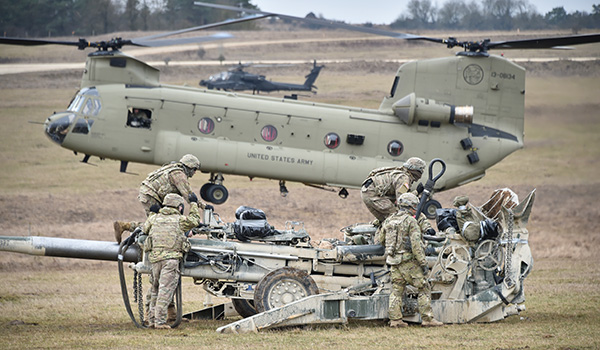
Aviation Branch Chief / By MG William K. Gayler: For those of us who weren’t there to witness the birth of Army Aviation, it is a humbling experience to recognize that today’s Army Aviators are the heirs to a 75-year legacy of unwavering support to Soldiers, shared sacrifice, and unprecedented innovation.

12th Combat Aviation Brigade aircraft conduct sling load operations with U.S. Soldiers assigned to Cobra Battery, Field Artillery Squadron, 2nd Cavalry Regiment during Exercise Dynamic Front II at the 7th Army Training Command’s Grafenwöhr Training Area, Germany, March 9, 2017. / U.S. ARMY PHOTO BY VISUAL INFORMATION SPECIALIST GERTRUD ZACH
In 2017, it might be easy to forget that while the Army gained an Aviation branch in 1983, our branch’s roots reach back to the years of World War II, driven by an urgent need to support Soldiers on the ground with Soldiers overhead who understood their fight and shared their challenges. 75 years later, our founding ethos and fundamental purpose remain unchanged: a lasting and unshakable commitment to ground commanders and Soldiers that serves as the compelling reason for Army Aviation to exist.
The passage of time may also make it easy to forget that the development of Army Aviation was not without its own growing pains. Our forebears worked through significant challenges –inter-service rivalries; debating, testing, and refining theories on how to best develop and employ emerging aviation capabilities; hard lessons learned fighting determined foes in Korea, Viet Nam, and elsewhere around the world; tough decisions about allocating finite Department of Defense, Army, and branch resources – to grow U.S. Army Aviation into the essential member of the combined arms team that it is today.
It is important that we recognize the sacrifices, ingenuity, and moral courage of Army Aviation’s founding proponents, who displayed remarkable innovative talent and positive spirit to repeatedly face and overcome skepticism, entrenched attitudes, and institutional inertia to deliver transformational capabilities to ground commanders. We owe the generations of pioneers who preceded us a debt of gratitude for their hard work in setting the conditions for us to succeed today in some of the most inhospitable environments our Army has ever had to confront. It is almost unfathomable to contemplate conducting combat operations in places like the jungles of Viet Nam or the mountains of Afghanistan without the critical capabilities that Army Aviation brings. These game-changing capabilities didn’t just spring into being of their own accord. Like today’s generation of Army aviators, our forebears had to overcome the ever-present dilemma of being ready to fight tonight – being ready, and at times testing it in the crucible of combat – while continuing to develop the future capabilities that we have inherited. It is a testament to their foresight and dedicated efforts that U.S. Army Aviation remains the best-trained and best-equipped force of its kind in the world.
Honoring those that came before us is our shared obligation – but honoring them is not enough. It is equally essential that we learn from them. The history of Army Aviation is rife with hard-won lessons, often paid for in blood and treasure, but to fully capitalize on the accomplishments of those who built our branch – to harness their achievements and to avoid the pitfalls of the past – requires us to exercise the wisdom and discipline to study and learn from their examples. This 75th Anniversary issue provides you a unique opportunity to do just that, reviewing the growth of our community through the eyes of those leaders who were there to witness and shape its legacy.
As professionals, we owe it to ourselves and those we have sworn to defend to make this effort, because the two-pronged challenge to fight tonight while continuing to develop the next generation of Army aviators and aviation capabilities remains as compelling today as it did 75 years ago. Though the challenges are many, we are in good hands. It is amazing to witness the talent, commitment, and warrior spirit of our current Army Aviation Soldiers and leaders. Thank you for your service and for doing your part in maintaining a collective sense of urgency to fulfill our sacred commitment to support Soldiers and commanders on the ground – in our business, lives are on the line every day. Never lose sight that what we do now sets conditions for those who will follow and inherit our Army and our Aviation branch.
Above the Best!
MG William K. Gayler is the Army Aviation branch chief and commander of the U.S. Army Aviation Center of Excellence and Fort Rucker, AL.










